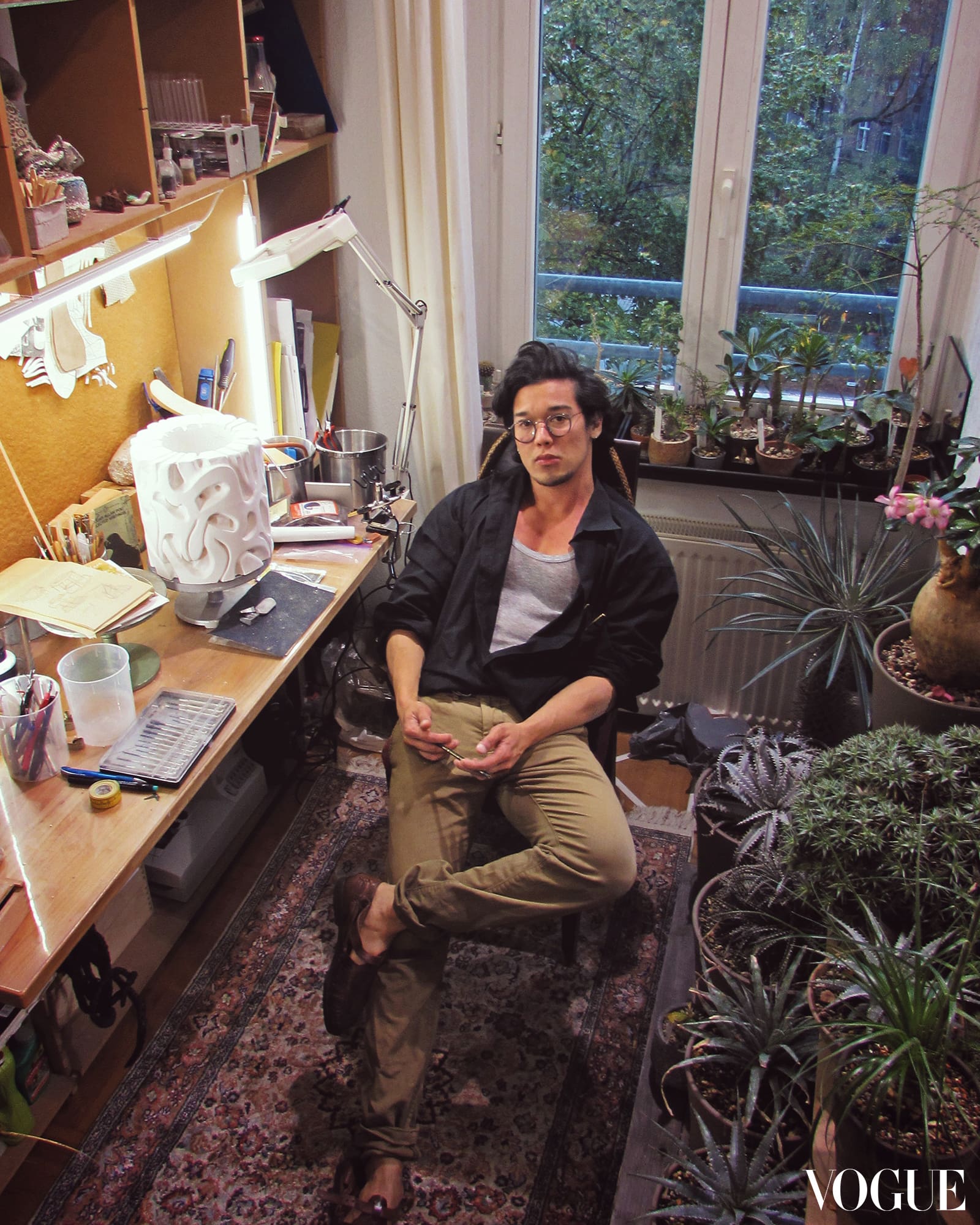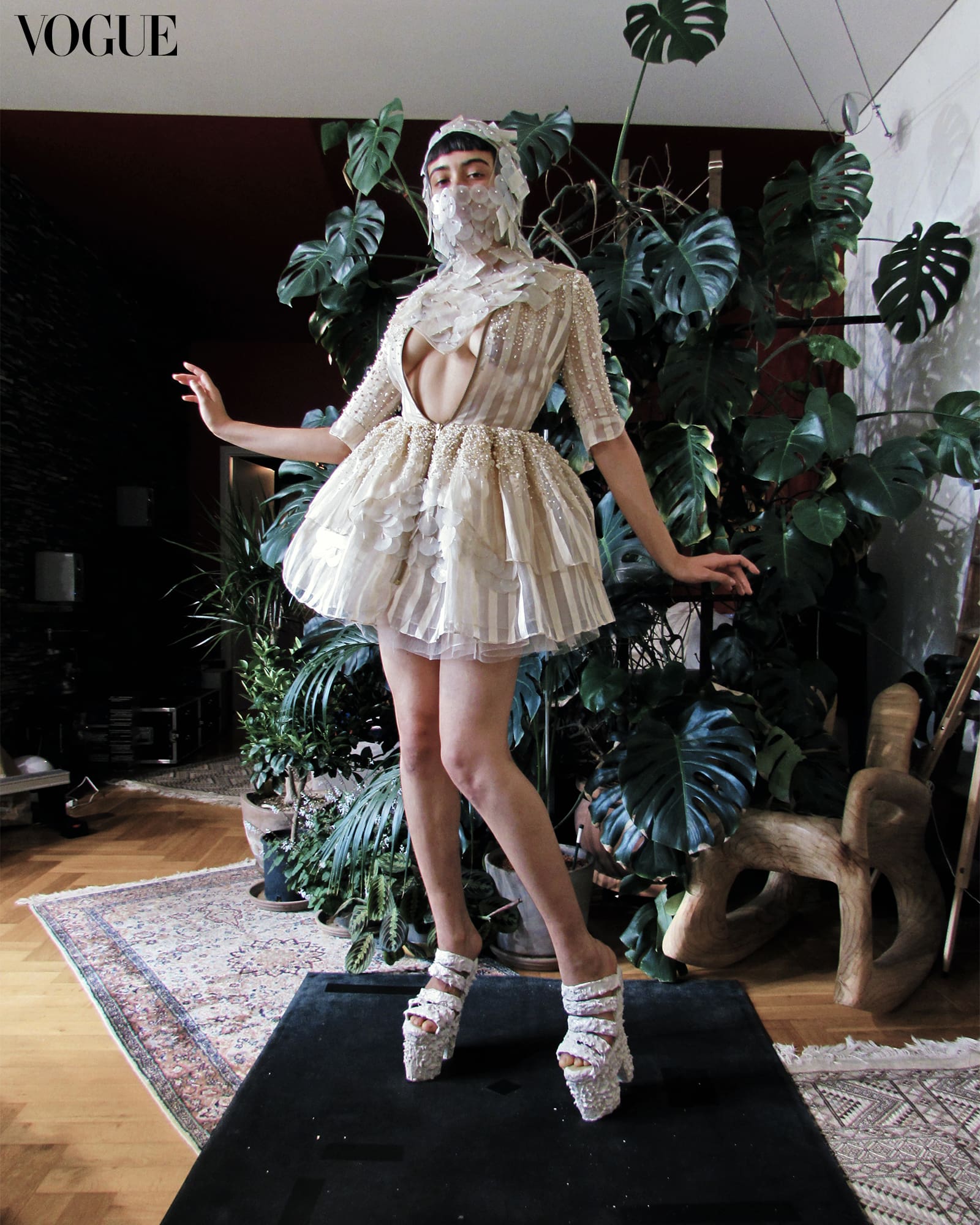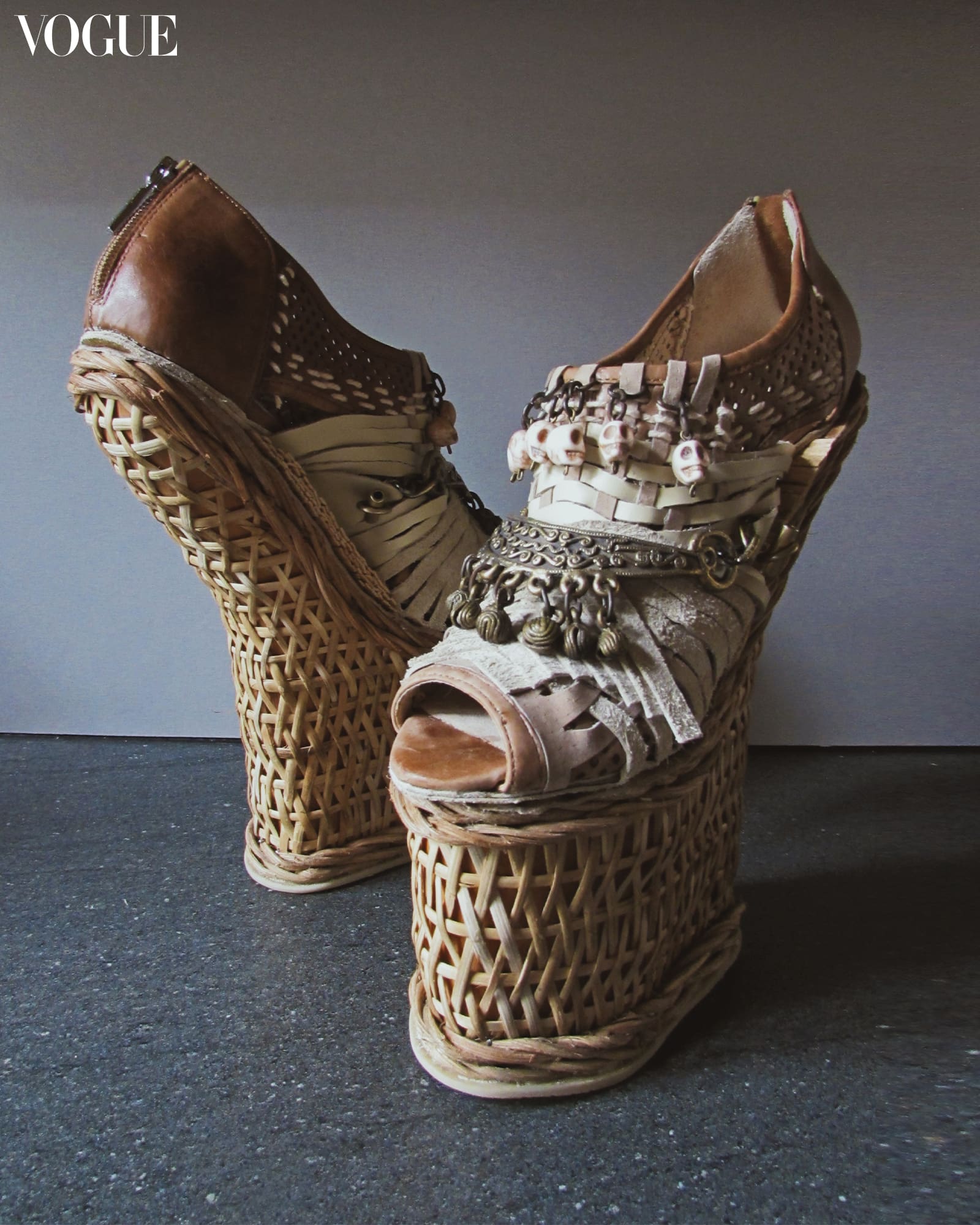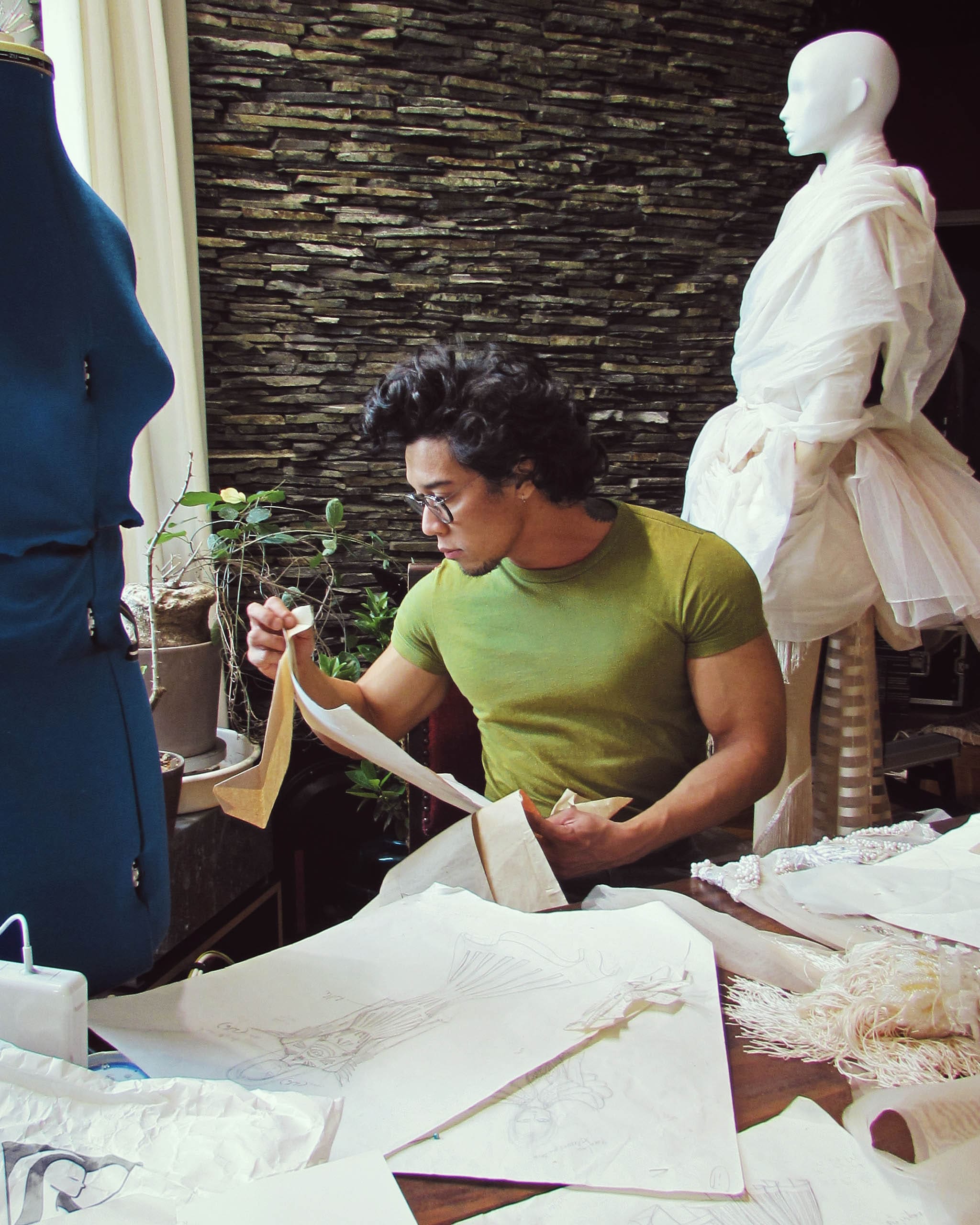Courtesy of Kermit Tesoro
Kermit Tesoro’s newest collection embraces the mystical and the modest.
Those familiar with Kermit Tesoro’s fashion world might imagine that his newest collection is an intoxicating jungle of rare butterflies, blooming tropical flowers, mythological headhunters, marble skulls, and gothic fairytales. However, for his new collection, Leucistic Observations, he has veered inward and homeward. A more earthly, humble spirit emanates from the muted beige and pastel-toned fabrics. It is a collection he was fated to make from birth, a collection that has roots in his mother’s birthplace in Laguna and his fascination with organic, traditional Filipino materials, craft and costumery.
Last year, Manila-born designer Kermit Tesoro returned to Quezon City from his home in Berlin. The internationally renowned designer’s idiosyncratic, animistic clothing and shoes have been worn by celebrities (most notably, Lady Gaga in 2010) and exhibited in numerous galleries and museums. But, far from the major fashion cities of Europe, Tesoro found his inspiration in the Philippines, from where he sourced the materials and the message for his latest collection.
It is a collection that combines pouffed sleeves, close-fitting bodices, feather-light, transparent layers and subtle geometric motifs and a sprinkling of pearls. It harks to a romantic interpretation of traditional costumes of the Philippines while boasting detailed, European-inspired tailoring. His collection is a reflection of Tesoro’s own identity: a Filipino in Berlin, a man living between two worlds in more ways than geographical.

Calling Berlin home was not a long-held desire for the designer. He was visiting with friends in Berlin in 2017 while launching an exhibition of his work in the city at the time. It was a city, he says, that embraced creativity, community, and queerness. In short, it felt like Berlin had opened its arms and invited Tesoro to make himself at home, which he did in 2018.
In the decade prior, Tesoro’s conceptual shoe designs had paraded down runways and been showcased in museums and galleries in Asia, Europe and the US. It was validating and exciting for the young designer, a graduate of the University of the Philippines’ College of Fine Arts, the Fashion Institute of the Philippines, and London’s famed Central Saint Martins.
It is early morning in Berlin when I call Tesoro, who is at home in the apartment he shares with his husband. He is enthusiastic to discuss Leucistic Observations, a project that has been years in the making, but has existed in his consciousness for at least a decade. It came to fruition when he returned to his homeland of the Philippines in July 2022, a trip that was “long overdue”, he explains.
“Considering that my materials for this collection are predominately sourced in the Philippines, that played a big role in why I went back. I was familiar with where those materials are located, which meant that I was able to glide smoothly to get those materials,” he says.There is a lightness and subtle elegance to the pieces from his most comprehensive, conceptual collection to date. The palette ranges from pearl to beige, pinks and muted gold. The collection is befittingly named after leucism, a condition in which a genetic mutation in certain animals affects their melanin, resulting in their skin or feathers bearing pale colours rather than the usual rich pigmentation of their species.
“I was thinking about this back in 2010,” says Tesoro. “It’s been an idea that has existed for a long time.”
There are embroidered bodices in muted beige that boast swirling silver and gold patterns, delicately edged with pearls; a high-collared, asymmetrical shirt dress is made of such light piña fabric that it seems to barely skim the body, nor weigh more than a feather. A flouncy dress bedecked in layers of tutu-like tulle is given a subtle modesty and regalness with its long sleeves, zippered high neck collar and tailored bodice.


In 2022, when he went to the Philippines to source mahogany wood, piña, bones, abaca, and bakong, he had already developed his knowledge of where to go and who to speak with.
Tesoro says, “I had decided to use those organic, traditional materials after contemplating it for years. I never had a chance because my ideas weren’t ripe enough and my resources and financial capacity were obstacles.
“I knew where to go for materials because my province is in Paete, Laguna, and I grew up playing around the streets of that town, which is the woodcarving capital of the Philippines. So, I was oriented towards seeing creativity around me from an early age. Our neighbours around Laguna made slippers, bakyâ, that look like wooden clogs. They’re the national footwear of the Philippines.”
Tesoro’s mother was raised in Laguna along with her nine siblings. “It was the quintessential Filipino family,” he tells me. “Parents and a large number of siblings. She travelled to Manila to study and began working and then she met my father in Manila and they created their family there. When I was very young, we lived in Quezon City and that’s where I grew up. Every weekend, we’d go back to the provinces to visit my grandfather and relatives, so as kids we were immersed in Laguna.”
The art of woodcarving is most evidently on display in the Akbay shoes Tesoro has crafted for Leucitic Observations. The high-platform soles are a carved, solid chunk of mahogany wood wrapped in a criss-crossed weave of rattan and bamboo.
Elsewhere, Tesoro has indulged his innate desire to extend and embellish the female silhouette. In one angelic jacket design, wing-like, ornate shoulders resemble blossoming pastel pink petals over a curving, graceful hem. It is perfectly partnered with a beaded, matching dress bearing a split front hem, tuxedo-style.
“The fabric I used is predominantly piña–pineapple fabric–and the rest is glass, acrylic beads, and artificial pearls. The piña fabric is sundried and prewashed, not bleached or anything, so it is naturally off-white. Piña is a bit like denim, there are different tones and washes.”
Five years ago, Tesoro exhibited his ornate, eccentric shoes—more art than fashion—as part of Cube Design Museum’s “Heaven or Hell? Extraordinary Shoe Design” show in Holland in 2018. Shoes had been his calling card for so long – not least The Polypodis (2015), resembling a sprawling octopus under the wearer’s foot, and the Foreskin shoes (2010). When Lady Gaga wore Tesoro’s designs in her 2010 “Marry The Night” video, a gothic, armour-like costume, it was a major milestone, but Tesoro had bigger ambitions than dressing celebrities.

The sort of ambitions that had been fostered in him from childhood, when he was given cheap laundry soap to “sculpt” while visiting family in Paete or being presented books on traditional Filipino costumes by his mother. It was in the pages of her books that young Kermit noticed high necks, prominent shoulders and puffed sleeves.
“The high necklines are an important factor for this collection,” he concedes. “I’m trying to convey modesty, humbleness and humility. I’m embracing scandalous, sometimes provocative and erotic ideas in my designs—mysticism, superstition, cults from the Philippines, even—but I want the clothes to be humble enough to carry those ideas. I didn’t want to be vulgar. The colour palette, too, is muted to curtain the violence. The whole idea of humility and modesty came from my mother. There’s definitely elements that stem from my mum.”
Tesoro’s designs have always emerged during some of the darkest periods of his life, perhaps as a wild manifestation of his emotions in resin, or as a healing distraction from grief. The Polypodis, bursting with colour and tentacles, began as a series of eccentric sketches he made after his beloved mother’s death in 2014. She’d been a co-conspirator, championing his wildest ideas and celebrating the international recognition her son was receiving.
The grief of her death is raw, still. Tesoro speaks about her with enormous love, and it is impossible to imagine that this newest collection is, at least partially, a homage to her.
“Truthfully, my mother and my connection to home were big factors,” he says. “My grief is still lingering. I still don’t know how to process my loss. I’m not sure if there’s a perfect recipe for someone to feel normal after losing a mum that you’re very close to.”
He recalls, “Mum gave me a book about traditional costumes, characters and stories, and the idea was so evident while she was still alive but as a young designer, I felt more inclined to use more modern materials. Using elements from the Philippines costumes felt like a bit of a novelty. I never disputed the idea with my mum because she really enjoyed looking at the silhouettes of Philippine costumes, but there’s so many limited rules as to how to approach using the materials.”
Throughout the design process, he has maintained contact with the Cultural Center of the Philippines (CCP), which oversees the respectful use of traditional fabrics. “I’m using very culturally valuable materials,” he admits. “In the back of my mind, throughout this process, I was thinking ‘What if I do something wrong, or something crass with the materials?’”
He is hoping that he might be able to show his work in the Philippines eventually, but next June, the Philippine Embassy in Berlin will be exhibiting Leucitic Observations as part of the 70th anniversary of Germany-Philippines diplomatic relations.
“Primarily, I would like these clothes to be exhibited rather than worn, so that people have a chance to observe, to speculate or scrutinise the details, because I’m proud of those details within the pieces of this collection. I really want to showcase the finer details that have various stories and interpretations.”
He adds, “Essentially, the point of the collection is me reaching out to my Filipino roots, and it would be a joy for my relatives to see how I’ve used these materials that are typically used in furniture or ornaments, and how I’ve layered in the superstitions and mysticisms that are commonly known in Filipino families.”
- Paris-based Filipino Designer Norman De Vera Celebrates His Creative Journey On The Global Stage
- Bella Hadid’s Head-Turning Helmet By Filipino Designer Chris Habana For The Heaven Fall 2023 Campaign
- Dutch-Filipino Designer Alyssa Marie Groeneveld Is Ready to Venture Off-Field
- PHx Conference 2023 Returns To Empower Filipino Designers To Enter The Global Scene
